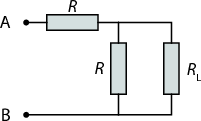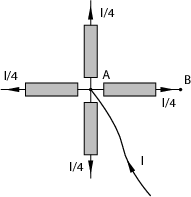Let us divide the cylinder into thin cylindrical shells. A shell of radius will have a surface current density . To find the magnetic field of such a shell, imagine that we bend it into a torus with perimeter . In the limit the torus is an infinitely long cylindrical shell, and we do not need to distinguish between its inner and outer perimeters. Using Ampère’s law and integrating along the “centre ring” of the torus we find that inside the torus. This also holds for a straight cylindrical shell. Outside .
Summing up the contributions of the shells we find that the magnetic field at distance from the axis of the cylinder is
For simplicity let us consider below.
Let the components of vectors and be denoted
and let . Now let us expand in Taylor series, and write the potential as
| (1) |
Here is the monopole term in the expansion of the potential, is the dipole term, the quadrupole, etc.
Let us define , , , … in the following way:
Now the terms of the potential’s expansion can be written as
Note that the coefficients , , … only depend on , but not . If we carried out the tedious calculations, for the first few -constants we would get , , , where is the Kronecker delta.
The monopole term in the potential is just proportional to the total charge , and does not depend on , hence it does not depend on the choice of origin of our coordinate system. What happens to the dipole term if the origin of the coordinate system is changed, or, equivalently, the charges are shifted by a vector ?
Note that if the total charge (and the monopole term in the potential) is 0, then does not change when the charges are shifted.
Now suppose that for any , and thus for each . When the charges are shifted, will be
Here we used the fact that to simplify the result. Note again that if and , then does not change when shifting the charges.
It can be shown in a similar way that any will be independent of the choice of origin of the coordinate system if for all and all .
Adding one more “step” to the infinite ladder will not change it. Let denote the resistance of the ladder.
|
|
The configuration of figure 1 must have resistance too:
The positive solution of this equation is
Similarly, if a current is flowing out from point , the voltage drop across resistor is .
According to the principle of superposition, when we have both a current flowing into point and a current flowing out from point , the voltage drop across will be . The resistance between points and is .
- Using Gauß’s law we find the electric field at distance
from a wire
(
is the linear charge density). The force on unit length
of the other wire is
- The moving wires have a current . It is easy to find the magnetic field using Ampère’s law (integrate along circular loops around the wire): . The force due to the magnetic interaction is attractive, so the total force is
The results in points (a) and (b) are not identical. However, the two presented situations are exactly the same setup, viewed from different reference frames.
This is a good illustration of Maxwell’s equations not being invariant to the classical Galilei–transformation (; ). If we take into account the change in charge density due to the relativistic Lorentz–contraction, , it is easy to show that the force is the same in both reference frames. (Use the relation .)

